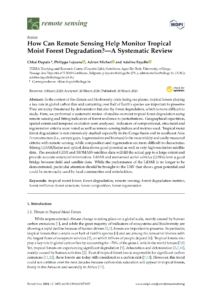
Dupuis C., Lejeune P., Michez A., Fayolle A.
Abstract: In the context of the climate and biodiversity crisis facing our planet, tropical forests playing a key role in global carbon flux and containing over half of Earth’s species are important to preserve. They are today threatened by deforestation but also by forest degradation, which is more dicult to study. Here, we performed a systematic review of studies on moist tropical forest degradation using remote sensing and fitting indicators of forest resilience to perturbations. Geographical repartition, spatial extent and temporal evolution were analyzed. Indicators of compositional, structural and regeneration criteria were noted as well as remote sensing indices and metrics used. Tropical moist forest degradation is not extensively studied especially in the Congo basin and in southeast Asia. Forest structure (i.e., canopy gaps, fragmentation and biomass) is the most widely and easily measured criteria with remote sensing, while composition and regeneration are more dicult to characterize. Mixing LiDAR/Radar and optical data shows good potential as well as very high resolution satellite data. The awaited GEDI and BIOMASS satellites data will fill the actual gap to a large extent and provide accurate structural information. LiDAR and unmanned aerial vehicles (UAVs) form a good bridge between field and satellite data. While the performance of the LiDAR is no longer to be demonstrated, particular attention should be brought to the UAV that shows great potential and could be more easily used by local communities and stakeholders.
Consultez la notice complète de l’article sur ORBi
